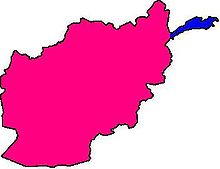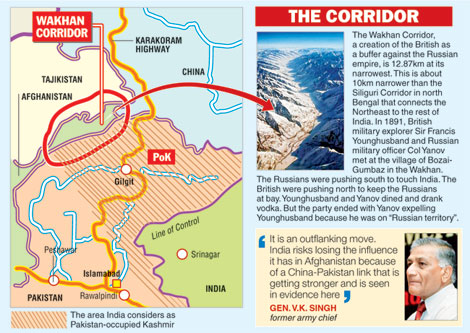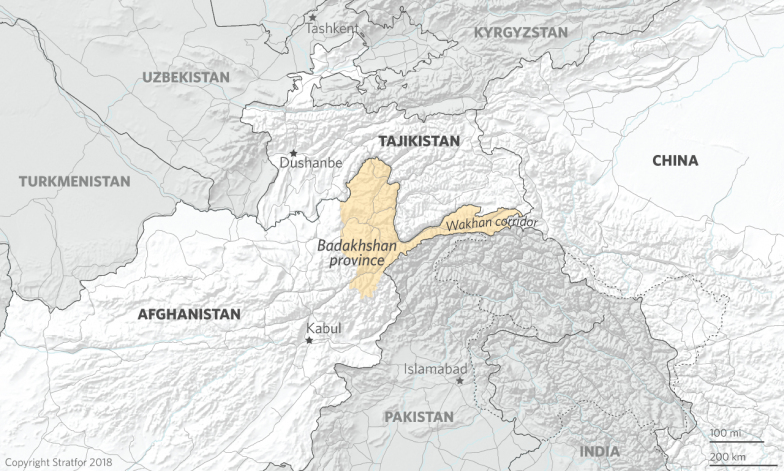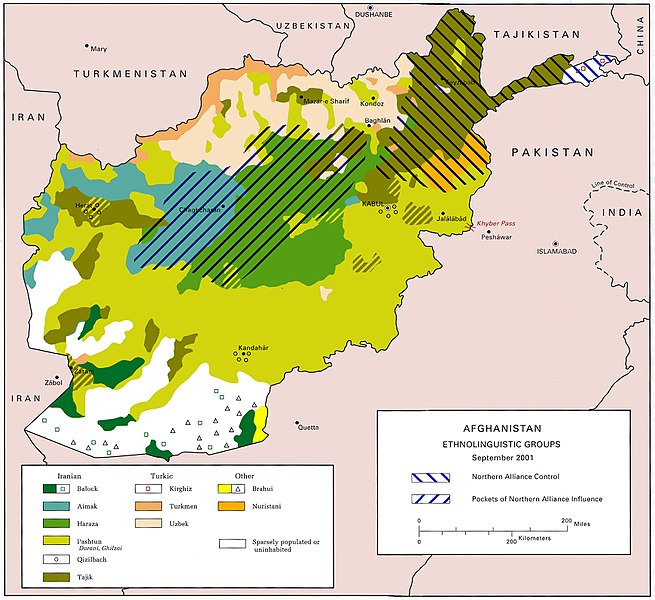Say Afghanistan and 99% of people will say “Pak”istan. Since America entered Afghanistan in 2001, the entire focus has been on the Afghan-NaPakistan border. That is but natural because that border is where the conflict between the Taleban & US forces has raged.
But the most obvious, the most active place is often not the place to enter a theater of conflict. Entering quietly from a backdoor can sometimes be a smart strategy. See where such a strategy has taken China.
Think back to January 2011 when “China & Tajikistan announced that they have settled their old border dispute. Under this settlement, Tajikistan ceded 386 sq miles or 1,000 sq km of land to China in the remote Pamir mountain range. China said that the move thoroughly solved their century-old border dispute“.
The Pamir range runs along Tajikistan’s border with Afghanistan and China. You read Tajikistan, Afghanistan & China and what comes to mind immediately? The famous Wakhan Corridor:
 The Wakhan Corridor forms the blue panhandle of Afghanistan’s Badakhshan Province. On the Chinese side of the border is Tashkurgan Tajik Autonomous County of Xinjiang Uyghur Autonomous Region. North of the blue Wakhan panhandle, is Tajikistan and below is the NaPak-occupied section of Kashmir. Pretty strategic area, wouldn’t you say?
The Wakhan Corridor forms the blue panhandle of Afghanistan’s Badakhshan Province. On the Chinese side of the border is Tashkurgan Tajik Autonomous County of Xinjiang Uyghur Autonomous Region. North of the blue Wakhan panhandle, is Tajikistan and below is the NaPak-occupied section of Kashmir. Pretty strategic area, wouldn’t you say?
But the Wakhan corridor and its 16,100 feet high Wakhjir Pass is closed during most of the year. So this is mostly a smuggler and terrorist route. That in itself makes this corridor important to China. But knowing China, we felt there just has to be something bigger, something long term behind China’s acquisition of 1,000 Sq Km from Tajikistan.
One possible answer came 18 months later via an interview by Telegraph with General V K Singh, the retired Chief of the Indian Army, an expert on the Wakhan Corridor:
 We discussed the idea of China building an all-weather tunnel underneath the Wakhan Corridor in our June 9, 2012 article titled Is This Why China Wanted the Land From Tajikistan?
We discussed the idea of China building an all-weather tunnel underneath the Wakhan Corridor in our June 9, 2012 article titled Is This Why China Wanted the Land From Tajikistan?
Remember 2012 was two years before President Obama’s announced withdrawal in 2014 of the bulk of US forces from Afghanistan. That was also the beginning of the terrible war in Syria which drew Muslim Uighur fighters from Chinese-occupied Xinjiang-Uighur autonomous region. That traffic of fighters was from Xinjiang into Afghanistan through the Wakhan Corridor and then further west.
Now the Syrian war is mostly over and foreign fighters are returning to their homelands. For China this means return of battle-hardened Muslim Uighur terrorists into Xinjiang through the Wakhan corridor. This is a serious defense issue for China and they can’t rely on weak Afghan forces to stop Uighurs from crossing the Wakhan Corridor. That brings us to this week.
Stratfor reported this week that “China plans to build a military base for Afghanistan’s armed forces in the northeastern province of Badakhshan“. According to Afghan Gen. Dawlat Waziri on Jan 7, per Stratfor, China will supply the base with “weapons, uniforms for soldiers, military equipment and everything else needed for its functioning,” and China “will move military vehicles through Tajikistan to Afghanistan“.
Besides being defensive, this military base will allow China to dominate the entire strategic theater that includes northeastern Tajikistan & Afghanistan and the Gilgit-Baltistan area of NaPak-occupied Kashmir. And in one blow, China has closed access to Tajikistan & Central Asia for the entire Indian Subcontinent including NaPakistan.
As Stratfor points out, this new base by China is not to compete with US presence in Afghanistan. In fact, “China prefers to have the United States bear most of the security burdens in Afghanistan. China is unable and unwilling to entangle itself too much in the country … “. Actually “this limited but growing Chinese presence in the area will be a net benefit to the overall U.S. security mission“, argues Stratfor.
Fast forward a bit and you will see how this new base by China in Badakshan could prove to be a big step in China’s One Belt One Road initiative in Eurasia. We just don’t believe any Afghan government in Kabul will be able to maintain a secure hold on their entire country. So naturally Afghanistan would slowly morph into ethnolinguistic sections in which neighboring powers have material influence & perhaps a form of control.
Thanks to its new military base, China would be in a position to dominate the northeastern (brown) section that encompasses Badakshan. Go east from Kabul and you get to Herat near the Iranian border. Herat and the green & blue ethnic sectors of Iranian origin will end up being influenced by Iran. The northern beige sector bordering western Tajikistan, Uzbekistan & Turkmenistan will be influenced by those countries which means by Russia.
That leaves the light green Pushtun area that includes Kabul, Kandahar and borders NaPakistan. That is the main area of US activity and US thrust under President Trump to eliminate terrorist camps on the Afghan-Napak line of control.
Iran and Russia have been long term players in Afghanistan. America has been the main force inside Afghanistan since 2001.The Afghan government in Kabul is essentially an American protectorate and it will continue to remain so.
China has been a peripheral and insignificant player in Afghanistan. Not for long. As China builds the new military base in Badakshan near the Wakhan corridor and as it works with Afghan forces to train & support them, China will become a major player in Northeastern Afghanistan & Tajikistan. And a China-Iran handshake across Afghanistan would benefit both of them and strengthen China’s One Belt One Road ambitions.
Given the steady encroachment by Russia & Iran into Afghanistan and now China’s entrance, we think America will end up staying in Afghanistan for a long time. As we wrote on October 10, 2009, Afghanistan is where the world meets on land and America cannot afford to not be there.
That puts America’s presence and interests directly in the path of the strategic interests of NaPakistan in Afghanistan, especially in the Pashtun areas of Afghanistan that span the line of control with NaPakistan. Ergo, the strong line drawn by President Trump about NaPak’s sanctuary for & support of terrorists who attack Afghanistan.
Kudos to China for its long term vision and commitment that began in 2011 with the acquisition of 386 square miles from Tajikistan. China’s entry will make Afghanistan an even more interesting theater than it is today.
Send your feedback to editor@macroviewpoints.com Or @MacroViewpoints on Twitter

